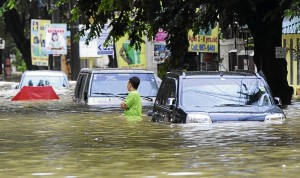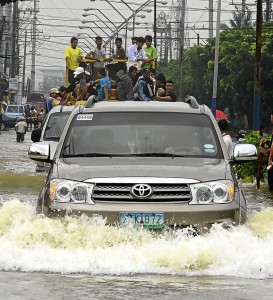Reviving your flood-damaged car
 Once again floods brought about by Typhoon “Gener” wrought havoc in Metro Manila and a fairly large number of cars were affected. Here’s a simple to-do list to make your car road-worthy again. Please note that regardless of your car’s condition, do not try starting/cranking your engine if you are in doubt. You might cause a short circuit, which at the very least can fry your car’s electronics, or worse, start a fire. Safety is always paramount.
Once again floods brought about by Typhoon “Gener” wrought havoc in Metro Manila and a fairly large number of cars were affected. Here’s a simple to-do list to make your car road-worthy again. Please note that regardless of your car’s condition, do not try starting/cranking your engine if you are in doubt. You might cause a short circuit, which at the very least can fry your car’s electronics, or worse, start a fire. Safety is always paramount.
Electricals
Take out your car’s battery by carefully removing the negative terminal, followed by the positive terminal. Turn on your headlights as sometimes some electrical power remains in your car’s wiring circuit, the lights will quickly drain out any power left. If you are well versed with basic hand tools, you can remove the engine control unit or module (ECU or ECM) and inspect it for damage/corrosion. You can also remove the starter motor, inspect and clean it, as well as the alternator and A/C compressor. For the A/C blower motor, you will probably require the services of an A/C cleaning shop to clean the blower motor thoroughly, as well as the A/C ducting. A bottle of electronic contact point cleaner or WD-40 is handy in situations like cleaning up electrical contact points, removing rust and ensuring good electrical conduction. After you’ve changed the battery, check all the fuses that might have popped, check/replace all the relays that might have shorted, and all the lights (headlights, foglamps, park lights, brake and reverse lights) as well as the horn, your audio system, interior lights, signal/emergency hazard lights, the A/C blower motor, etc.
Engine
Remove your sparkplugs and high-tension cables, drain your engine oil completely and remove your air filter. You can use compressed air to flush out all the old oils contaminated with water. Then, refill with cheap but good-quality mineral oil and a brand-new oil filter. With the spark plugs and ignition coils or high-tension cables removed (basically, the top of the engine is open), install a new battery (do not use your old, flood damaged or even submerged battery), disconnect both the fuel pump wiring or fuse, and the ignition system fuse or wiring, and crank the engine to flush out all the fluids that might have come inside the combustion chamber and they will come shooting out like geysers from the sparkplug holes on top of your engine, so better be careful. Keep doing this until no more water and oil come out. Some people use diesel oil because of its higher concentration of carbon cleaning detergents. So long as you won’t be running your car for more than a few kilometers on this, your engine will be fine should you do this. You can augment the flushing procedure further by using high-quality engine oil flush chemicals such as those offered by Motul.
Transmission/drivetrain
If your car went underwater, chances are your transmission fluid, whether an automatic or any of its derivatives (torque-converter equipped automatic, automated manual transmission or a dual-clutch transmission) or a plain-jane self-shifting manual, will have to be changed. For manuals, you can usually just drain the transmission fluid until it is completely empty, then pour in new transmission fluid. But if your transmission is an automatic equipped with a torque converter, you will need to use a Transtec ATF fluid flushing device so that you can drain the transmission fluid out of the torque converter thoroughly.
For manuals and automated manuals, inspect your clutch friction disks because chances are the chemical properties of the clutch disks were harmed by the water (which is why you install clutches with very clean hands) and will start slipping, cracking, warping or glazing. You will most likely need to replace them. If your car has a transfer case or is rear wheel drive with a separate differential housing out back, flush out the differential fluid thoroughly. Once you’ve changed all the transmission fluids, Tommy Teng of DTM Motorsports recommends that you drive the car around gently for a few kilometers to get all the impurities out, then flush your transmission fluid again, inspect the flushed-out oil, and if still has impurities, do the process all over again.
You’ll also need to check your axle boots. Debris in the floodwaters might have damaged the axle boots, so they might need replacing, and the heavy-duty grease inside the axle boots might need to be changed and the axles repacked with new grease.
Lastly, check your wheel bearings for smoothness of action and signs of contamination and deterioration. Water might have penetrated the seals in your wheel bearings and you might need to repack them with new grease, or if these are sealed wheel bearings, a replacement might be in order.
Suspension
There’s not much that can be damaged in your suspension, but if your car went underwater/submerged for an extended period of time, flood water might have dried up the lubricants on the shock absorber pistons, which in turn can damage the oil and weather seals in your shock absorber. Being submerged in flood water can also cause the seals to start leaking. Once your car starts, check out how the suspension feels. If it feels bouncy and harsh, chances are your shock absorbers have leaked out all its hydraulic fluids. Replace them and get your vehicle’s alignment checked.
Brakes, clutch and steering
Brake, clutch and power steering fluids are hydraulic fluids, which are hygroscopic, i.e., they absorb moisture over time which affects performance, cause fade which is a loss of consistency in performance causing unpredictable handling characteristics and boil-over. Imagine these fluids being submerged in water? Yup, you get the picture. Replace these at once, and make sure you flush out everything as moisture suspended in the fluids can damage dust seals, causing your components to start leaking, which can leave you stranded (clutch fluid), crash (no brakes) or cause an accident (very heavy to almost no power steering assist).
Interior
Remove everything you can remove in the interior: seats, seat covers, carpet, rear parcel shelf, matting, center console and even the dashboard if you are so inclined. Wash these in heavy-duty detergent to get the sewer smell out and dry them in intense sunlight until these are completely dry. While the interior is stripped, dry up the interior, use soap and water to clean up as much as you can, and remember to scrape off all the mud and dirt inside to prevent rut and corrosion. You can check the wires underneath the carpet to see if these are frayed or damaged, and you can make the necessary repairs possible. You can also cover up underchassis holes with duct tape and rubber gum to prevent water from going into the car and causing further corrosion. If the smell won’t go away, here’s a tip: buy a sachet of the most powerful-smelling laundry detergent and place it in a small plastic cup inside the car. You can buy two or more sachets of laundry detergent, put these in separate small plastic cups and place them in different areas in the car. The detergent smell will overpower the smell of everything else. Your car’s interior will smell like detergent for three to four days, but afterwards the smell will vanish completely altogether. As a small bonus, you can still use the detergent to wash clothes because the loss of smell will not affect the detergent’s performance either.
Fuel system
Now is a good time to pull down your gas tank, inspect the fuel pump, replace the fuel filter and fuel pump strainer and thoroughly clean the gas tank inside and out with heavy duty detergent and water to remove dirt, debris, humidity and moisture. A clean fuel tank with a new strainer and fuel filter will make your car run much more efficiently, make more power and have better fuel economy. Fuel mixed with water or other contaminants will clog your fuel injectors and damage them, foul up your spark plugs, create more carbon deposits, lower your fuel’s effective octane rating and cause pre-ignition/detonation, which will lead to serious engine damage if left unattended.
Tire inspection
Your vehicle might not have been victimized by the floods, but you might have been forced to drive on flooded streets and picked up debris that could have imbedded itself into your tires. Bring it to a wheel alignment shop, have them check your tires thoroughly for slow leaks and punctures, and vulcanize/replace the tires accordingly. Being up on a lift is also a good chance to inspect your car’s underside for any further evidence of rust/damage/corrosion or debris that might have gotten caught, snagged or stuck to your car.
These steps and tips seem daunting, but with professional help, some money well spent and some time to understand the intricacies of what we’re doing, your car will be more fuel-efficient, more reliable, ultimately safer and will last longer.


